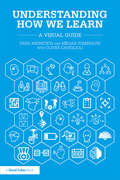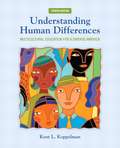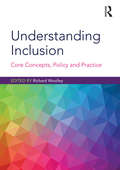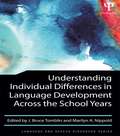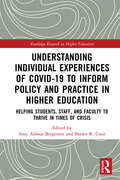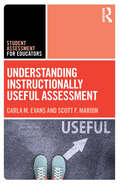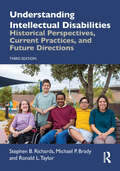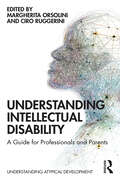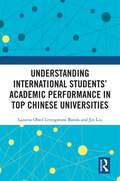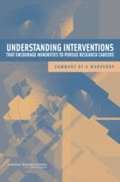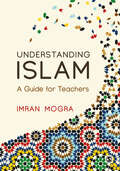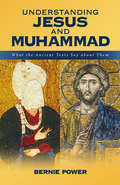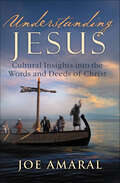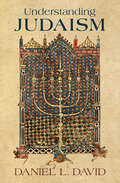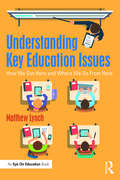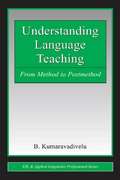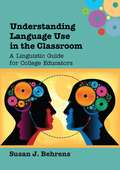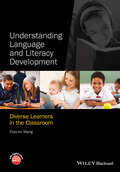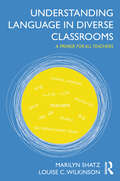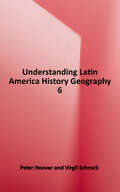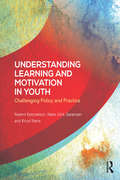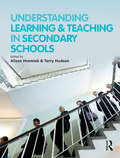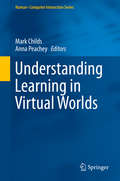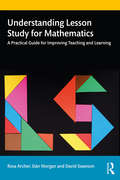- Table View
- List View
Understanding How We Learn: A Visual Guide
by Yana Weinstein Oliver Caviglioli Megan SumerackiEducational practice does not, for the most part, rely on research findings. Instead, there’s a preference for relying on our intuitions about what’s best for learning. But relying on intuition may be a bad idea for teachers and learners alike. This accessible guide helps teachers to integrate effective, research-backed strategies for learning into their classroom practice. The book explores exactly what constitutes good evidence for effective learning and teaching strategies, how to make evidence-based judgments instead of relying on intuition, and how to apply findings from cognitive psychology directly to the classroom. Including real-life examples and case studies, FAQs, and a wealth of engaging illustrations to explain complex concepts and emphasize key points, the book is divided into four parts: Evidence-based education and the science of learning Basics of human cognitive processes Strategies for effective learning Tips for students, teachers, and parents. Written by "The Learning Scientists" and fully illustrated by Oliver Caviglioli, Understanding How We Learn is a rejuvenating and fresh examination of cognitive psychology's application to education. This is an essential read for all teachers and educational practitioners, designed to convey the concepts of research to the reality of a teacher's classroom.
Understanding Human Differences: Multicultural Education for a Diverse America, Fourth Edition
by Kent L. KoppelmanIn Understanding Human Differences,readers are introduced to sound research grounded in various behavioral and social sciences while featuring a stimulating inquiry approach to support reflection on issues of critical importance in multicultural education in today’s diverse society. The conceptual framework of the book focuses on three areas: culture, the individual, and institutions. Readers are encouraged to examine individual concerns; understand the cultural/historical contexts; and explore such areas as racism, classism, sexism, heterosexism, and ableism. Included is a focus on changes already achieved or that need to be implemented in schools and other areas of society to create a more just society.
Understanding Inclusion: Core Concepts, Policy and Practice
by Richard WoolleyUnderstanding Inclusion is a rich, comprehensive exploration of inclusion in education, challenging us to think about being ‘inclusive’ in its broadest sense. It unpicks a wide range of complex themes and issues that impact on educational practice, supporting educational professionals in helping teachers and learners understand difference as the norm, and not the exception. Underpinned by the latest research, discussion is brought to life through vignettes of real experiences and examples of practice from a range of settings and across continents. Chapters consider crucial aspects of inclusion: Social inclusion and social class Global perspectives on culture and identity Aspirations and social mobility Relationships and sexual behaviours Gender equality and diversity Perceptions of ability and disability Barriers to learning Multilingualism in schools Religion and belief Restorative justice for inclusion Inclusion and the arts Teaching Assistants and inclusion The central role of leadership. Written by experts with extensive experience in a range of educational contexts, Understanding Inclusion is designed for all those engaged in understanding the complexities of teaching and learning. With reflective questions and selected reading designed to support further study, it will be essential reading for students on Education Studies and related course, and pre- and in-service teachers.
Understanding Individual Differences in Language Development Across the School Years
by J. Bruce Tomblin Marilyn A. NippoldThis volume presents the findings of a large-scale study of individual differences in spoken (and heard) language development during the school years. The goal of the study was to investigate the degree to which language abilities at school entry were stable over time and influential in the child’s overall success in important aspects of development. The methodology was a longitudinal study of over 600 children in the US Midwest during a 10-year period. The language skills of these children -- along with reading, academic, and psychosocial outcomes -- were measured. There was intentional oversampling of children with poor language ability without being associated with other developmental or sensory disorders. Furthermore, these children could be sub-grouped based on their nonverbal abilities, such that one group represents children with specific language impairment (SLI), and the other group with nonspecific language impairment (NLI) represents poor language along with depressed nonverbal abilities. Throughout the book, the authors consider whether these distinctions are supported by evidence obtained in this study and which aspects of development are impacted by poor language ability. Data are provided that allow conclusions to be made regarding the level of risk associated with different degrees of poor language and whether this risk should be viewed as lying on a continuum. The volume will appeal to researchers and professionals with an interest in children’s language development, particularly those working with children who have a range of language impairments. This includes Speech and Language Pathologists; Child Neuropsychologists; Clinical Psychologists working in Education, as well as Psycholinguists and Developmental Psychologists.
Understanding Individual Experiences of COVID-19 to Inform Policy and Practice in Higher Education: Helping Students, Staff, and Faculty to Thrive in Times of Crisis (Routledge Research in Higher Education)
by Amy Aldous BergersonUtilizing findings from more than 200 interviews with students, staff, and faculty at a US university, this volume explores the immediate and real-life impacts of COVID-19 on individuals to inform higher education policy and practice in times of crisis. Documenting the profound impacts that COVID-19 had on university operations and teaching, this text foregrounds a range of participant perspectives on key topics such as institutional leadership and loss of community, managing motivation and the move to online teaching and learning, and coping with the adverse mental health effects caused by the pandemic. Far from dwelling on the negative, the volume frames the lived experiences and implications of COVID-19 for higher education through a positive, progressive lens, and considers how institutions can best support individual and collective thriving during times of crisis. This text will benefit researchers, academics, and educators in higher education with an interest in the sociology of education, higher education management, and eLearning more broadly. Those specifically interested in student affairs practice, as well as the administration of higher education, will also benefit from this book.
Understanding Instructionally Useful Assessment (Student Assessment for Educators)
by Carla Evans Scott MarionUnderstanding Instructionally Useful Assessment offers new insights into how various types of assessments, from the state to the classroom, will differ in their usefulness for supporting instructional decision-making and student learning. In order to most effectively serve students, it is essential that educators avoid conflating the assessment information that teachers use for instructional purposes and the data that leaders and administrators use for evaluative or monitoring purposes. This book provides classroom teachers as well as school and district leaders with a clear conception of what makes assessments—their purpose, design, reporting, and resulting information—useful or not for informing instruction and how they can select assessment tools suited to specific purposes. Each chapter addresses the knowledge and skills that K-12 staff need in order to challenge claims made by policymakers, test vendors, or even other educators that any assessment can be used to inform instruction. Educators will come away better prepared to remove unnecessary or redundant assessments from their systems and to create structures, policies, and processes that best support the instructional usefulness of assessments for student learning.
Understanding Intellectual Disabilities: Historical Perspectives, Current Practices, and Future Directions
by Ronald L. Taylor Stephen B. Richards Michael P. BradyThe third edition provides thorough coverage of the causes and characteristics of intellectual disabilities as well as detailed discussions of the validated instructional approaches in the field today. A revised "Future Directions" chapter explores the most recent philosophical, social, legal, medical, educational, and personal issues that professionals and people with intellectual disabilities face. All chapters have been updated with recent developments in research and the newest terminology being used in the field. This comprehensive and current introductory textbook is ideally suited for introductory or methods courses related to intellectual disabilities.
Understanding Intellectual Disability: A Guide for Professionals and Parents (Understanding Atypical Development)
by Margherita Orsolini Ciro RuggeriniUnderstanding Intellectual Disability: A Guide for Professionals and Parents supports professionals and parents in understanding critical concepts, correct assessment procedures, delicate and science-infused communication practices and treatment methods concerning children with intellectual disabilities. From a professional perspective, this book relies on developmental neuropsychology and psychiatry to describe relevant measures and qualitative observations when making a diagnosis and explores the importance of involving parents in the reconstruction of a child’s developmental history. From a parent’s perspective, the book shows how enriched environments can empower children’s learning processes, and how working with patients, families, and organizations providing care and treatment services can be effectively integrated with attachment theory. Throughout seven chapters, the book offers an exploration of diagnostic procedures, new insights on the concept of intelligence and the role of communication and secure attachment in the mind’s construction. With expertise from noteworthy scholars in the field, the reader is given an overview of in-depth assessment and intervention practices illustrated by several case studies and examples, as well as a lifespan perspective from a Human Rights Model of disability. Understanding Intellectual Disability is an accessible guide offering an up-to-date vision of intellectual disability and is essential for psychologists, health care professionals, special educators, students in clinical psychology, and parents. Things are connected through invisible bonds: you cannot pluck a flower without unsettling a star. Galileo Galilei
Understanding International Students’ Academic Performance in Top Chinese Universities
by Lazarus Obed Banda Jin LiuCombining theory and case studies, this book explores the factors that influence the academic success of international students in China. It emphasizes the importance of cultural understanding and tailored support systems in improving academic outcomes.The authors utilize the Social Cognitive Theory (SCT) to examine how students' academic outcomes are shaped by personal, environmental, and behavioral factors, especially given the unique challenges in a rapidly globalizing educational environment. Using a mix of quantitative and qualitative methodologies, this book investigates various aspects of academic performance, including motivation, self-regulation, and cultural adaptation. A key focus is the application of Attribution Theory, which studies how students' beliefs about the causes of their academic success or failure affect their motivation and behavior. The authors also discuss the impact of institutional factors, such as faculty support and the quality of educational resources, on student performance.The title will appeal to scholars and students interested in student mobility, student performance, Chinese education, and international education in China. It also serves as a valuable read for educators and policymakers relevant to the context of China's increasing prominence as a destination for international education.
Understanding Interventions That Encourage Minorities To Pursue Research Careers: Summary Of A Workshop
by National Research Council of the National AcademiesMinority groups are severely underrepresented in the scientific workforce. To encourage minorities to pursue careers in research, a variety of "intervention programs" have been created at the pre-college, college, and graduate school levels. While there is a belief that these programs often achieve their goals, there is relatively little understanding of the factors that contribute to that success. The Division of Minority Opportunities in Research (MORE) at the National Institute of General Medical Sciences of the National Institutes of Health has established a grant program to support research to better understand the factors that contribute to the success of intervention programs. The MORE Division asked the National Academies to organize a workshop focusing on issues addressed by the grant program. This workshop summary presents examples of previous research on intervention programs, describes ways to formulate effective research questions and conduct research to identify the key elements that lead to successful intervention programs, and outlines ways to foster a community of researchers in this area.
Understanding Islam: A Guide for Teachers
by Imran MograMisconceptions and misunderstandings about Islam and fear of causing offence can be barriers to being an effective teacher in a diverse school. This book aims to give non-Muslim teachers the confidence to engage meaningfully with important facets of Muslim pupils&’ lives leading to a richer and more rewarding experience in the classroom. Aspects of Islam explored include: the foundations and obligations of faith, ethical dimensions placed upon Muslims, the importance of education in Muslim communities and contemporary issues faced by communities in the UK. To deepen your understanding, each chapter is enriched by case studies linked to the classroom, expert voices that offer authenticity and reflective tasks that encourage you to consider key concepts in greater depth. This is essential reading for new and experienced teachers in primary and secondary schools wishing to deepen their knowledge of Islam.
Understanding Islam: A Guide for Teachers
by Imran MograMisconceptions and misunderstandings about Islam and fear of causing offence can be barriers to being an effective teacher in a diverse school. This book aims to give non-Muslim teachers the confidence to engage meaningfully with important facets of Muslim pupils&’ lives leading to a richer and more rewarding experience in the classroom. Aspects of Islam explored include: the foundations and obligations of faith, ethical dimensions placed upon Muslims, the importance of education in Muslim communities and contemporary issues faced by communities in the UK. To deepen your understanding, each chapter is enriched by case studies linked to the classroom, expert voices that offer authenticity and reflective tasks that encourage you to consider key concepts in greater depth. This is essential reading for new and experienced teachers in primary and secondary schools wishing to deepen their knowledge of Islam.
Understanding Jesus and Muhammad: What the ancient texts say about them
by Bernie PowerJesus and Muhammad are arguably the two most influential individuals who have ever lived. Over half of the world today claims to follow them and the religions they founded: Christianity and Islam.But who were these two men? Where did they come from? What did they do and teach? And what was their vision for the future?Understanding Jesus and Muhammad answers all these questions, drawing on the earliest ancient documents we have about them.In the light of the current tensions that exist in the world, the future of civilisation may well depend on how humanity responds to Jesus and Muhammad.
Understanding Jesus: Cultural Insights into the Words and Deeds of Christ
by Joe AmaralModern-day Christians often bring their own presuppositions and assumptions to the reading of the Bible, not realizing how deeply their understanding of Christ's life and teachings is affected by a 21st-century worldview. In Understanding Jesus, author Joe Amaral delves deep into Jewish history, societal mores, and cultural traditions, closing the gap created by geographical distance and over two thousand years of history. Using a chronological approach to the life of Christ, he guides the reader through significant events such as Jesus' birth, baptism, and crucifixion, pointing out illuminating details that that the Western mind would normally miss.Amaral's premise is that to understand Jesus, we must understand the time and place in which he was born, the background from which he drew his illustrations, and the audience he spoke to. Throughout the book he explores specific terms, places, and events for their significance and shows how they add richness and meaning to the text. Topics include the connection between Jesus and John the Baptist, the annual Feasts and why they are important to modern Christianity, Jewish customs such as foot-washing, clean and unclean foods, paying tribute to political governments, and the significance of various miracles.In Understanding Jesus, Amaral draws back the curtain on a way of life that existed during the reign of the Caesars, and in doing so, reveals truths about the way we live more than two thousand years later, half a world away.
Understanding Judaism
by Daniel L DavidThe quintessential introduction to Jewish beliefs, practices and traditions by the rabbi and director of the New York Federation of Reform Synagogues.Rabbi Daniel L. Davis was a leader of Reform Judaism. His classic text, Understanding Judaism, has been widely used by Jews and non-Jews alike since it was first published in 1958. A popular volume for those attending conversion courses, if offers a fuller grasp of Jewish religion and culture. From basic concepts in Judaism to institutions, practices, and the organization of Jewish life in America, Rabbi Davis presents a comprehensive overview of the subject. This volume also includes vocabulary terms of Jewish interest and usage, a self-review section, and an extensive reading list on everything from Jewish history to Jewish literature.
Understanding Key Education Issues: How We Got Here and Where We Go From Here
by Matthew LynchIn this age of education innovation and reform, schools must evolve and react to current policy trends. This accessible book offers research-based insights into six key educational trends and issues that are impacting K–12 learning today: year-round schooling, assessments, educating minorities, anti-intellectualism, issues of social promotion and retention, and school design. Each chapter unpacks research and policy issues relating to these topics and provides administrators with practical advice on how they should approach these issues to improve learning in their schools. The ideas and strategies in Understanding Key Education Issues will help educators across the country achieve greater efficiency, better results, and a higher purpose.
Understanding Language Teaching: From Method to Postmethod (ESL & Applied Linguistics Professional Series)
by B. KumaravadiveluThis book traces the historical development of major language teaching methods in terms of theoretical principles and classroom procedures, and provides a critical evaluation of each. Drawing from seminal, foundational texts and from critical commentaries made by various scholars, Kumaravadivelu examines the profession's current transition from method to postmethod and, in the process, elucidates the relationship between theory, research, and practice. The chief objective is to help readers see the pattern that connects language, learning, teaching methods, and postmethod perspectives.In this book, Kumaravadivelu:*brings together a critical vision of L2 learning and teaching--a vision founded at once on historical development and contemporary thought;*connects findings of up-to-date research in L2 learning with issues in L2 teaching thus making the reader aware of the relationship between theory, research and practice;*presents language teaching methods within a coherent framework of language-, learner-, and learning-centered pedagogies, thus helping the reader to see how they are related to each other;*shows how the three categories of methods evolved historically leading ultimately (and inevitably) to the emergence of a postmethod condition; and*provides the reader with a solid background in several interconnected areas of L2 pedagogy, such as concepts of competence, input factors, intake processes, interactional modifications, and instructional design.Understanding Language Teaching: From Method to Postmethod is intended for an international audience of teacher educators, practicing teachers and graduate students, researchers, curriculum planners, and materials designers in the field of second and foreign language teaching.
Understanding Language Use in the Classroom
by Susan J. BehrensIt is clear that a proper understanding of what academic English is and how to use it is crucial for success in college, and yet students face multiple obstacles in acquiring this new 'code', not least that their professors often cannot agree amongst themselves on a definition and a set of rules. Understanding Language Use in the Classroom aims to bring the latest findings in linguistics research on academic English to educators from other disciplines, and to help them help their students learn and achieve. Behrens combines a powerful argument for the importance of explicit teaching of language skills in college with answers to common questions from professors and students, as well as sample teaching materials to help make these issues come alive in the classroom.
Understanding Language and Literacy Development
by Xiao-Lei WangUnderstanding Language and Literacy Development: Diverse Learners in the Classroom offers effective supporting strategies to address the cultural and linguistic diversity of students in contemporary classrooms. Discusses learners with different linguistic abilities--infancy, early childhood, middle childhood, and adolescence--by suggesting effective ways to reach them based on their strengths and needs Emphasizes language and literacy supporting strategies in a variety of everyday classroom settings Includes activities and questions to motivate readers to think and develop their own perspectives on language and literacy development Considers a variety of different language acquisition experiences, including monolingual, multilingual, and language impairment Discusses different types of literacies, including digital and hypertext Connects language and literacy development to identity and motivation to contextualize learning styles for pre-service teachers Supported by a companion website that includes additional resources such as PowerPoint presentations by chapter and a summary of relevant information from the Common Core K-12 English Language Arts Standards
Understanding Language in Diverse Classrooms: A Primer for All Teachers
by Marilyn Shatz Louise C. WilkinsonWith the increasing linguistic and cultural diversity of students in U. S. schools, all teachers, regardless of the content area or grade they teach, need research-based strategies for assisting all students to gain English proficiency. This practical, concise guide shows teachers what they need to know about language, how it is learned, how it is used, and how teaching about it can be incorporated into lessons throughout the curriculum. Understanding Language in Diverse Classrooms offers a model of how learning takes place and describes the critical role of teachers in that model. It includes comparison charts showing how some of the most common heritage languages represented among present-day students compare with English, and it provides examples of hands-on materials including checklists, rating scales, and sample lessons to help teachers prepare to teach all their students in diverse classrooms. Each chapter ends with questions to stimulate discussion and reflection on major chapter points, to enable readers to review and evaluate the information and then integrate it into their own practice.
Understanding Latin America: A Christian Perspective (Understanding God's World Ser.)
by Peter Hoover Virgil SchrockThis hardcover textbook covers the geography and history of Latin American countries from a Biblical viewpoint. Geographical and political features of the countries are emphasized and map skills are taught. The last four chapters begin with a study of the ancient Indian empires, cover the Spanish conquest of the New World, and move on to modern times.
Understanding Learning and Motivation in Youth: Challenging Policy and Practice
by Knud Illeris Noemi Katznelson Niels Ulrik SørensenThrough interviews with a selection of the most qualified and well-reputed Northern European researchers, Understanding Learning and Motivation in Youth explores, and offers a range of solutions to, one of the central problems in modern education: motivation for learning. The way that teaching is currently delivered to students aged 11–19 often does not support positive learning; the ongoing encouragement to produce as much competence as possible at the lowest possible costs elicits critical conditions for learning processes, endangering not only the motivation of students, but also the engagement and motivation of teachers themselves. This book examines how this can be handled in practice by teachers and educators, drawing on the perspectives of carefully selected experts to provide an introduction to the debates surrounding neoliberal education, as well as a means to counteract the damages in their everyday teaching and activities. With an original and accessible format and a unique insight into the thoughts of a select group of academics, Understanding Learning and Motivation is essential reading for students, researchers and academics studying the effects of neoliberal education, as well as practicing teachers and educational leaders who are attempting to combat the problem.
Understanding Learning and Teaching in Secondary Schools
by Terry Hudson Alison HramiakUnderstanding Learning and Teaching in Secondary Schools has been specifically researched, written and developed to inform, support and guide anyone training to become a secondary teacher today. This comprehensive new text strikes a balance between the depth of theory covered in the book and its practical application in the classroom. The authors introduce and explore key ideas and issues in an accessible, highly readable way, inviting you to reflect on your own practice and challenge both your own and others' thinking.
Understanding Learning in Virtual Worlds
by Anna Peachey Mark ChildsSince the publication of the companion volume Researching Learning in Virtual Worlds in 2010, there has been a growth not only in the range and number of educational initiatives taking place in virtual worlds, but also in the depth of analysis of the nature of that education. Understanding Learning in Virtual Worlds reflects those changes through a collection of chapters that are extended versions of research presented at the second Researching Learning in Virtual Environments conference (ReLIVE 11), an international conference hosted by the Open University UK. Included in this book are chapters that explore the philosophical and methodological underpinnings of understanding learning in virtual worlds, identify and analyse the factors that support learning in these environments, and present case studies that demonstrate some of the various ways in which virtual worlds can be applied to facilitate learning and teaching. The links between learning in a virtual world and learning in the physical world are made apparent throughout, and the authors reveal how understanding learning in one informs the other. Understanding Learning in Virtual Worlds is an important book not only to those who teach in virtual worlds, but to anyone for whom understanding learning, in all its forms, is of interest.
Understanding Lesson Study for Mathematics: A Practical Guide for Improving Teaching and Learning
by David Swanson Siân Morgan Rosa ArcherUsing the latest research, this book provides an insight into how learning in mathematics can be improved through a lesson study approach. This highly practical resource explores the research and theory that underpins lesson study, and shows the significant impact it can have on teacher development. Divided into ten accessible main chapters that focus in depth on an individual mathematics lesson, each chapter provides research and background to the lesson, an outline of key features, a detailed description and analysis of the lesson in practice, post-lesson discussions and reflections which generalise from the experience, as well as links to helpful resources. Some of the key topics explored include: Fractions Proportional relationships Probability and statistics Geometry Modelling Algebra Dialogic reasoning. Understanding Lesson Study for Mathematics is the perfect resource for all mathematics teachers, trainee teachers, and professional developers who are looking to develop the use of lesson study in their own practice or for those simply seeking new inspiring ideas for the mathematics classroom.
